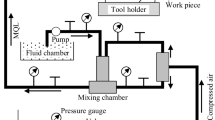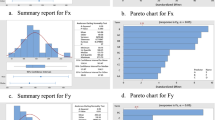Abstract
In this paper, a tool life test was performed using PVD-coated insert on Inconel 718 (IN718) samples in milling machining. A single cutting condition was considered with two machining environments. The tool life was tested on an IN718 workpiece fabricated through conventional (cast and wrought) and additive (selective laser melting) process routes. The as-built SLM samples were subjected to two heat treatments such as hot isostatic pressing (HIP) and aeronautic heat treatment (AHT). This study aimed to evaluate the machining behavior of C&W and SLM IN718 from the machining point of view such as tool wear, chip appearance, surface roughness, and residual stresses. The tool life tests were performed under two machining environments, such as dry and near dry environment using minimum quantity lubrication (MQL). Meanwhile, the tool wear propagation under different cutting conditions is also explored. Under both the cutting conditions, flank wear and fracture of the cutting edge are the most predominant failure modes minimizing the tool life. The microhardness, surface roughness, and residual stress measurements were analyzed. The result indicates that the microstructural difference between the C&W and SLM has more influence on the tool life compared to the machining environment. On machining, the SLM sample has 80% and 43% more tool life than the C&W in dry and MQL machining. Comparing the dry and MQL machining of SLM, on using MQL, the tool life is 30% less compared to the dry machining.














Similar content being viewed by others
Availability of data and material
All data generated or analyzed during this study are included in this published manuscript.
“The authors declare that submitted work is original and has not been published elsewhere in any form or language.”
Abbreviations
- v c :
-
Cutting speed, m/min
- f z :
-
Feed rate, mm/tooth
- a p :
-
Depth of cut, mm
- a e :
-
Radial depth of cut, mm
- v b :
-
Flank wear, mm
- t c :
-
Cut in time, min
- f s :
-
Chip segmentation frequency (Hz)
- ∅ :
-
Cutting-edge angle, degrees
- p :
-
Pitch, µm
- t e :
-
Equivalent chip thickness, µm
- t 1 :
-
Maximum chip thickness, µm
- t 2 :
-
Minimum chip thickness, µm
- δ :
-
Delta phase
- γ′:
-
Gamma single prime
- γ″:
-
Gamma double prime
- Q w :
-
Dissipation of heat in the workpiece, Watts
References
Debroy T, Wei HL, Zuback JS et al (2018) Progress in Materials Science Additive manufacturing of metallic components – process, structure and properties. Prog Mater Sci 92:112–224. https://doi.org/10.1016/j.pmatsci.2017.10.001
Schmidt M, Merklein M, Bourell D et al (2017) Laser based additive manufacturing in industry and academia. CIRP Ann 66:561–583. https://doi.org/10.1016/j.cirp.2017.05.011
European Powder Metallurgy Association EA (2012) Introduction to additive manufacturing technology. 1–44
Zhang B, Li Y, Bai Q (2017) Defect formation mechanisms in selective laser melting: a review. Chin J Mech Eng. https://doi.org/10.1007/s10033-017-0121-5
Tofail SAM, Koumoulos EP, Bandyopadhyay A et al (2018) Additive manufacturing: scientific and technological challenges, market uptake and opportunities. Mater Today 21:22–37. https://doi.org/10.1016/j.mattod.2017.07.001
Azam FI, Majdi A, Rani A et al (2018) An in-depth review on direct additive manufacturing of metals. https://doi.org/10.1088/1757-899X/328/1/012005
Keshavarzkermani A, Sadowski M, Ladani L (2018) Direct metal laser melting of Inconel 718: process impact on grain formation and orientation. J Alloy Compd 736:297–305. https://doi.org/10.1016/j.jallcom.2017.11.130
Hosseini E, Popovich VA (2019) A review of mechanical properties of additively manufactured Inconel 718. Addit Manuf 30:100877. https://doi.org/10.1016/j.addma.2019.100877
Cooke S, Ahmadi K, Willerth S, Herring R (2020) Metal additive manufacturing: technology, metallurgy and modelling. J Manuf Process 57:978–1003. https://doi.org/10.1016/j.jmapro.2020.07.025
Moussaoui K, Rubio W, Mousseigne M et al (2018) Effects of Selective Laser Melting additive manufacturing parameters of Inconel 718 on porosity, microstructure and mechanical properties. Mater Sci Eng A 735:182–190. https://doi.org/10.1016/j.msea.2018.08.037
Babu SS, Love L, Dehoff R et al (2015) Additive manufacturing of materials: opportunities and challenges. MRS Bull 40:1154–1161. https://doi.org/10.1557/mrs.2015.234
Chlebus E, Gruber K, Kuźnicka B et al (2015) Effect of heat treatment on the microstructure and mechanical properties of Inconel 718 processed by selective laser melting. Mater Sci Eng A 639:647–655. https://doi.org/10.1016/j.msea.2015.05.035
Zhong C, Gasser A, Kittel J et al (2016) Improvement of material performance of Inconel 718 formed by high deposition-rate laser metal deposition. Mater Des 98:128–134. https://doi.org/10.1016/j.matdes.2016.03.006
Smith DH, Bicknell J, Jorgensen L et al (2016) Microstructure and mechanical behavior of direct metal laser sintered Inconel alloy 718. Mater Charact 113:1–9. https://doi.org/10.1016/j.matchar.2016.01.003
Peng H, Shi Y, Gong S et al (2018) Microstructure, mechanical properties and cracking behaviour in a γ′ - precipitation strengthened nickel-base superalloy fabricated by electron beam melting. Mater Des 159:155–169. https://doi.org/10.1016/j.matdes.2018.08.054
Ni M, Chen C, Wang X et al (2017) Anisotropic tensile behavior of in situ precipitation strengthened Inconel 718 fabricated by additive manufacturing. Mater Sci Eng A 701:344–351. https://doi.org/10.1016/j.msea.2017.06.098
Yeh A, Lu K, Kuo C et al (2011) Effect of serrated grain boundaries on the creep property of Inconel 718 superalloy. Mater Sci Eng A 530:525–529. https://doi.org/10.1016/j.msea.2011.10.014
Tucho WM, Cuvillier P, Sjolyst-Kverneland A, Hansen V (2017) Microstructure and hardness studies of Inconel 718 manufactured by selective laser melting before and after solution heat treatment. Mater Sci Eng A 689:220–232. https://doi.org/10.1016/j.msea.2017.02.062
Zhou N, Lv DC, Zhang HL et al (2014) ScienceDirect Computer simulation of phase transformation and plastic deformation in IN718 superalloy: microstructural evolution during precipitation. 65:270–286. https://doi.org/10.1016/j.actamat.2013.10.069
Lee S, Rasoolian B, Silva DF et al (2021) Surface roughness parameter and modeling for fatigue behavior of additive manufactured parts: a non-destructive data-driven approach. Addit Manuf 46:102094. https://doi.org/10.1016/j.addma.2021.102094
Periane S, Duchosal A, Vaudreuil S et al (2019) Machining influence on the fatigue resistance of Inconel 718 fabricated by selective laser melting (SLM). Procedia Structural Integrity 19:415–422. https://doi.org/10.1016/j.prostr.2019.12.045
Sharman A, Dewes RC, Aspinwall DK (2001) Tool life when high speed ball nose end milling Inconel 718™. J Mater Process Technol 118:29–35. https://doi.org/10.1016/S0924-0136(01)00855-X
Shokrani A, Dhokia V, Newman ST (2012) Environmentally conscious machining of difficult-to-machine materials with regard to cutting fluids. Int J Mach Tools Manuf 57:83–101. https://doi.org/10.1016/j.ijmachtools.2012.02.002
Rinaldi S, Imbrogno S, Rotella G et al (2019) Physics based modeling of machining Inconel 718 to predict surface integrity modification. Procedia CIRP 82:350–355. https://doi.org/10.1016/j.procir.2019.04.150
Zhu D, Zhang X, Ding H (2013) Tool wear characteristics in machining of nickel-based superalloys. Int J Mach Tools Manuf 64:60–77. https://doi.org/10.1016/j.ijmachtools.2012.08.001
Farahnakian M, Keshavarz ME, Elhami S, Razfar MR (2019) Effect of cutting edge modification on the tool flank wear in ultrasonically assisted turning of hardened steel. Proc Inst Mech Eng Part B J Eng Manuf 233:1472–1482. https://doi.org/10.1177/0954405416640416
Farahnakian M, Elhami S, Daneshpajooh H, Razfar MR (2017) Mechanistic modeling of cutting forces and tool flank wear in the thermally enhanced turning of hardened steel. Int J Adv Manuf Technol 88:2969–2983. https://doi.org/10.1007/s00170-016-9004-7
Zhang RY, Qin HL, Bi ZN et al (2020) Evolution of lattice spacing of gamma double prime precipitates during aging of polycrystalline Ni-base superalloys: an in situ investigation. Metall Mater Trans A 51:574–585. https://doi.org/10.1007/s11661-019-05536-y
Sharma AK, Tiwari AK, Dixit AR (2016) Effects of Minimum Quantity Lubrication (MQL) in machining processes using conventional and nanofluid based cutting fluids: A comprehensive review. J Clean Prod 127:1–18. https://doi.org/10.1016/j.jclepro.2016.03.146
Musfirah AH, Ghani JA, Haron CHCC et al (2017) Tool wear and surface integrity of inconel 718 in dry and cryogenic coolant at high cutting speed. Wear 376–377:125–133. https://doi.org/10.1016/j.wear.2017.01.031
Aramesh M, Montazeri S, Veldhuis SC (2018) A novel treatment for cutting tools for reducing the chipping and improving tool life during machining of Inconel 718. Wear 414–415:79–88. https://doi.org/10.1016/j.wear.2018.08.002
Elhami S, Razfar MR, Farahnakian M (2016) Experimental study of surface roughness and tool flank wear during hybrid milling. Mater Manuf Processes 31:933–940. https://doi.org/10.1080/10426914.2015.1048474
Jeyapandiarajan P, Xavior MA (2017) Experimental investigations on the machinability of Inconel 718 under different cutting conditions. 38:295–304
Shokrani A, Dhokia V, Newman ST (2017) Hybrid cooling and lubricating technology for CNC milling of Inconel 718 nickel alloy. Procedia Manuf 11:625–632. https://doi.org/10.1016/j.promfg.2017.07.160
Oliveira ARF, da Silva LRR, Baldin V et al (2021) Effect of tool wear on the surface integrity of Inconel 718 in face milling with cemented carbide tools. Wear 476:203752. https://doi.org/10.1016/j.wear.2021.203752
Addona DMD, Raykar SJ, Narke MM et al (2017) High speed machining of Inconel 718: tool wear and surface roughness analysis. Procedia CIRP 62:269–274. https://doi.org/10.1016/j.procir.2017.03.004
Xu J, Ma T, Peng RL, Hosseini S (2021) Effect of post-processes on the microstructure and mechanical properties of laser powder bed fused IN718 superalloy. Addit Manuf 48:102416. https://doi.org/10.1016/j.addma.2021.102416
Niang A (2010) Contribution à l’étude de la précipitation des phases intermétalliques dans l’alliage 718. Thèse
Periane S, Duchosal A, Vaudreuil S et al (2020) Selection of machining condition on surface integrity of additive and conventional Inconel 718. Procedia CIRP 87:333–338. https://doi.org/10.1016/j.procir.2020.02.092
Kouraytem N, Varga J, Amin-ahmadi B et al (2021) A recrystallization heat-treatment to reduce deformation anisotropy of additively manufactured Inconel 718. Mater Des 198:109228. https://doi.org/10.1016/j.matdes.2020.109228
Kuo YL, Horikawa S, Kakehi K (2017) Effects of build direction and heat treatment on creep properties of Ni-base superalloy built up by additive manufacturing. Scripta Mater 129:74–78. https://doi.org/10.1016/j.scriptamat.2016.10.035
Quan Y, He Z, Dou Y (2008) Cutting heat dissipation in high-speed machining of carbon steel based on the calorimetric method. Front Mech Eng China 3:175–179. https://doi.org/10.1007/s11465-008-0022-5
Huang Y, Liang SY (2004) Modeling of CBN tool flank wear progression in finish hard turning. J Manuf Sci Eng T ASME 126:98–106. https://doi.org/10.1115/1.1644543
Akhyar Ibrahim G, Che Haron CH, Abdul Ghani J et al (2011) Performance of PVD-coated carbide tools when turning inconel 718 in dry machining. Adv Mech Eng. https://doi.org/10.1155/2011/790975
Ezugwu EO, Wang ZM, Machado AR (1998) The machinability of nickel-based alloys: a review. J Mater Process Technol 86:1–16. https://doi.org/10.1016/S0924-0136(98)00314-8
Priyadarshini A, Pal SK, Samantaray AK (2012) Finite element modeling of chip formation in orthogonal machining. Stat Comput Techn Manuf 9783642258:101–144. https://doi.org/10.1007/978-3-642-25859-6_3
Rakesh M, Datta S (2020) Machining of Inconel 718 using coated WC tool: effects of cutting speed on chip morphology and mechanisms of tool wear. Arab J Sci Eng 45:797–816. https://doi.org/10.1007/s13369-019-04171-4
Wang C, Xie Y, Zheng L et al (2014) Research on the chip formation mechanism during the high-speed milling of hardened steel. Int J Mach Tools Manuf 79:31–48. https://doi.org/10.1016/j.ijmachtools.2014.01.002
Acknowledgements
The authors thank INSA Euromed, University of Fes, Morocco, for the fabrication support and Cutting tool research and study center operators (CEROC, France) for machining support. Institut Pprime gratefully acknowledges “Contrat de Plan Etat–Région Nouvelle-Aquitaine (CPER)” as well as the “Fonds Européen de Développement Régional (FEDER)” for their support to the reported work.
Funding
“The authors declare that no funds or grants were received during the preparation of this manuscript.”
Author information
Authors and Affiliations
Contributions
Planning and sample fabrication were completed by SébastienVaudreuil, Hicham Chibane, and Sasidharan Periane Natarajan. The heat treatment and material characterization were completed by Jonathan Cormier and Sasidharan Periane Natarajan. The machining tests were completed by Sasidharan Periane Natarajan, Arnaud Duchosal, Antoine Morandeau, and Michael Anthony Xavior. The writing and original draft preparation were done by Sasidharan Periane Natarajan. The supervision and optimization of the article were completed by René Leroy, Arnaud Duchosal, Michael Anthony Xavior, and Jonathan Cormier. All authors have given approval to the final version of the manuscript.
Corresponding author
Ethics declarations
Ethics approval
Not applicable.
Consent to participate
Not applicable.
Consent for publication
Not applicable.
Competing interests
The authors declare no competing interests.
Additional information
Publisher's note
Springer Nature remains neutral with regard to jurisdictional claims in published maps and institutional affiliations.
Rights and permissions
About this article
Cite this article
Periane Natarajan, S., Vaudreuil, S., Chibane, H. et al. Tool life and surface integrity characteristics in milling of SLM and C&W inconel 718 in dry and MQL condition. Int J Adv Manuf Technol 121, 647–659 (2022). https://doi.org/10.1007/s00170-022-09327-5
Received:
Accepted:
Published:
Issue Date:
DOI: https://doi.org/10.1007/s00170-022-09327-5




